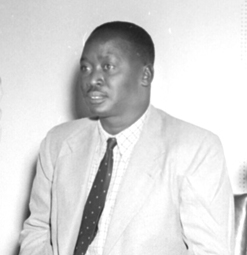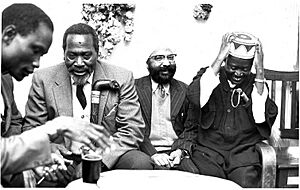Jaramogi Oginga Odinga facts for kids
Quick facts for kids
Jaramogi Oginga Odinga
|
|
|---|---|
 |
|
| 1st Vice-President of Kenya | |
| In office 12 December 1964 – 14 April 1966 |
|
| President | Jomo Kenyatta |
| Preceded by | Office Established |
| Succeeded by | Joseph Murumbi |
| Personal details | |
| Born |
Obadiah Adonijah
October 1911 Bondo, British East Africa |
| Died | 20 January 1994 (aged 82) Kisumu, Kenya |
| Political party |
List
Kenya African Union (1948–1959) Kenya African National Union (1960–1966) Kenya People's Union (1966–1990) Forum for the Restoration of Democracy (1991) Forum for the Restoration of Democracy – Kenya (1992–1994) |
| Spouses | Mary Juma (d. 1984) Gaudencia Adeya Susan Agik Betty Adongo |
| Children | 17 (including Oburu and Raila) |
| Alma mater | Makerere University |
| Occupation | Politician |
| Profession | Teacher |
Jaramogi Ajuma Oginga Odinga (born October 1911 – died 20 January 1994) was a very important Kenyan politician. He played a big part in Kenya becoming independent from British rule.
He became Kenya's first Vice-President. Later, he led the opposition parties. His son, Raila Odinga, also became a prime minister. Another son, Oburu Odinga, was an assistant minister.
Jaramogi is famous for the phrase "Not Yet Uhuru." This is the title of his book, published in 1967. "Uhuru" means freedom in the Swahili language. He believed that Kenya had not truly gained freedom, even after independence. This was because the government still treated opposition groups harshly. For example, his son Raila Odinga was held in prison for eight years.
Contents
Early Life and Education
Oginga Odinga was born in October 1911. His village was Nyamira Kang'o, in Bondo. His parents were Mama Opondo Nyamagolo and Odinga Raila.
He was given the Christian names Obadiah Adonijah. Later, he chose to use his original African names, Oginga Odinga. He studied at Maseno School and Alliance High School. In 1940, he went to Makerere University. After finishing his studies, he returned to Maseno High School as a teacher. In 1948, he joined the political party called Kenya African Union (KAU).
Becoming a Leader
Odinga wanted to help his ethnic group, the Kenyan Luo. He started a business group called the Luo Thrift and Trading Corporation in 1947. He worked to bring Luo people across East Africa closer together.
His efforts made him very respected among the Luo. They called him Ker, which was a title for a great king. This title was once held by a famous Luo king named Ramogi Ajwang. Ramogi Ajwang lived about 400 years before Odinga. Odinga promised to follow Ramogi Ajwang's good ideas. Because of this, he became known as Jaramogi, meaning "man of the people of Ramogi."
Kenya's First Vice-President
According to Luo traditions, a Ker (king) cannot be a politician. So, in 1957, Odinga gave up his role as king. He then became the main political voice for the Luo people.
In the same year, he was elected to the Legislative Council. This was a governing body for the Central Nyanza area. In 1958, he joined the Kenya African Union (KAU). He also helped start the Kenya Independence Movement in 1959. In 1960, he joined the Kenya African National Union (KANU) with Tom Mboya.
When Kenya became a Republic in 1964, Jaramogi Oginga Odinga became its first Vice-President.
Disagreements and Resignation
As Vice-President, Odinga often disagreed with President Jomo Kenyatta's government. Odinga wanted Kenya to have stronger ties with countries like People's Republic of China and the Soviet Union. However, President Kenyatta preferred to work closely with the United States and Western countries.
These disagreements led to Odinga resigning from his position. He also left the KANU party in 1966. After leaving, he formed his own political party, the Kenya People's Union (KPU).
Leading the Opposition
The disagreements between Odinga and Kenyatta continued. In 1969, Odinga was arrested. This happened after a public event in Kisumu where they argued. During the event, riots broke out, and many people were hurt or killed.
The event was when President Kenyatta was opening a new hospital in Kisumu. This hospital was seen as Odinga's project because of his connections with Russia. After this incident, the KPU party was banned. This made Kenya a country with only one main political party, KANU. Odinga and other KPU members were held for eighteen months. They were freed on 27 March 1971.
Odinga was not allowed to be active in politics for a long time. This changed after President Kenyatta died in August 1978.
Return to Politics
Kenyatta's successor, Daniel arap Moi, gave Odinga a job. He was made chairman of the Cotton Lint and Seed Marketing Board. But Odinga did not stay in this job for long. He continued to speak out against Kenyatta's past policies. Odinga even accused Kenyatta of taking land unfairly.
In 1982, Odinga tried to start a new political party. However, a new law was passed that year. This law made Kenya officially a single-party state. This stopped his plans.
After a failed attempt to overthrow Moi's government in 1982, Odinga was placed under house arrest again. In 1990, he tried again to register an opposition party, the National Democratic Party, but he was unsuccessful.
In 1991, he helped create and became the temporary leader of the Forum for the Restoration of Democracy (FORD). The creation of FORD started many changes in Kenya's politics. These changes eventually led to KANU losing power in 2002. This was eight years after Odinga's death.

Before the 1992 elections, FORD split into different groups. Odinga ran for president with the Ford-Kenya party. He came in fourth place, getting 17.5% of the votes. However, he did win back his seat in the Bondo Constituency. He had been out of parliament for over twenty years.
Odinga passed away in 1994 at the Aga Khan Hospital in Kisumu. He is buried at the Jaramogi Oginga Odinga Mausoleum in his home area of Bondo.
Family Life
Odinga had four wives: Mary Juma, Gaudencia Adeya, Susan Agik, and Betty Adongo. He had seventeen children in total. Mary was the mother of his sons Raila and Oburu. Mary passed away in 1984.
Global Ideas
Jaramogi Oginga Odinga was one of the people who signed an agreement to create a meeting. This meeting was to write a world constitution. Because of this, a World Constituent Assembly met to write a "Constitution for the Federation of Earth."
See also

